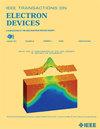使用冷阴极的线性交叉场放大器中的射频放大
IF 3.2
2区 工程技术
Q2 ENGINEERING, ELECTRICAL & ELECTRONIC
引用次数: 0
摘要
实验研究了一种低频(561 MHz)注入波束线性格式的门控场发射阵列交叉场放大器(CFA),并与仿真进行了比较。CFA在特氟龙曲线电路上使用铜线,迟滞率为~21。采用8个硅尖GFEA模具作为注入电子源,提供高达160 mA的电流。采用分节式末端集电极系统(9个电极)测量了有增益和无增益时束流电流的空间变化。在- 2.9 kV的空穴电压、~160 mA的注入电流、0.0125 T的外加磁场、15w的射频输入功率和2cm的空穴间隙条件下,获得了~5.5 dB的增益。CST粒子胞内模型的增益比实验高(~1 ~ 2 dB),但增益随注入电流、电压和磁场的变化规律吻合良好。在实验中,随着射频输入功率的变化,增益在15w以上显着下降,在25w之后的模拟中观察到的下降。对端集电极电流的分析表明,实验值为12w,仿真值为25w后,端集电极电流迅速减小。这是因为高度摆线电子靠近CFA电路,在提供放大能量之前被收集在电路上。这一观察结果在仿真中得到了证实,表明进入电路的电流迅速增大,而端集电极电流迅速减小。这种效应也解释了在模拟中观察到的更高增益。这些实验为利用门控场发射器研究微波真空电子器件中的波束相互作用提供了基础。本文章由计算机程序翻译,如有差异,请以英文原文为准。
Radio Frequency Amplification in a Linear Crossed-Field Amplifier Using Cold Cathodes
A low-frequency (561 MHz), injected beam, and linear format crossed-field amplifier (CFA) using gated field emission arrays (GFEAs) has been experimentally studied and compared with simulation. The CFA uses a copper wire on Teflon meander line circuit with retardation of ~21. Eight silicon tip GFEA dies were used as the injected electron source to provide up to 160 mA. A segmented end-collector system (nine electrodes) was used to measure the spatial variation of the beam current with and without gain. A gain of ~5.5 dB was measured for a sole-circuit voltage of −2.9 kV, an injected beam current of ~160 mA, an applied magnetic field of 0.0125 T, a radio frequency (RF) input power of 15 W, and a sole-circuit gap of 2 cm. A CST particle in-cell model shows a high gain (~1–2 dB) than the experiment, but the gain variation versus injected current, voltage, and magnetic field matches well. Variation with RF input power shows a significant decrease in gain above 15 W in the experiment with the decrease seen in simulation observed after 25 W. Analysis of the end-collector current shows a rapid decrease after 12 W in the experiment and 25 W in the simulation. This result occurs because the highly cycloidal electrons are close to the CFA circuit and get collected on the circuit before providing amplification energy. This observation is confirmed in simulation, which shows that the current going to the circuit rapidly increases and the end-collector current rapidly decreases. This effect also accounts for the higher gain observed in simulation. These experiments provide a basis for using gated field emitters to study beam–wave interactions in microwave vacuum electron devices.
求助全文
通过发布文献求助,成功后即可免费获取论文全文。
去求助
来源期刊

IEEE Transactions on Electron Devices
工程技术-工程:电子与电气
CiteScore
5.80
自引率
16.10%
发文量
937
审稿时长
3.8 months
期刊介绍:
IEEE Transactions on Electron Devices publishes original and significant contributions relating to the theory, modeling, design, performance and reliability of electron and ion integrated circuit devices and interconnects, involving insulators, metals, organic materials, micro-plasmas, semiconductors, quantum-effect structures, vacuum devices, and emerging materials with applications in bioelectronics, biomedical electronics, computation, communications, displays, microelectromechanics, imaging, micro-actuators, nanoelectronics, optoelectronics, photovoltaics, power ICs and micro-sensors. Tutorial and review papers on these subjects are also published and occasional special issues appear to present a collection of papers which treat particular areas in more depth and breadth.
 求助内容:
求助内容: 应助结果提醒方式:
应助结果提醒方式:


